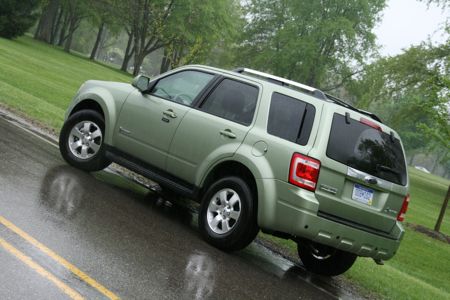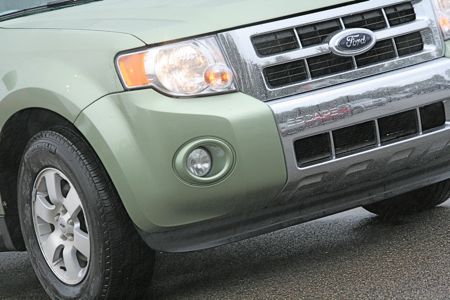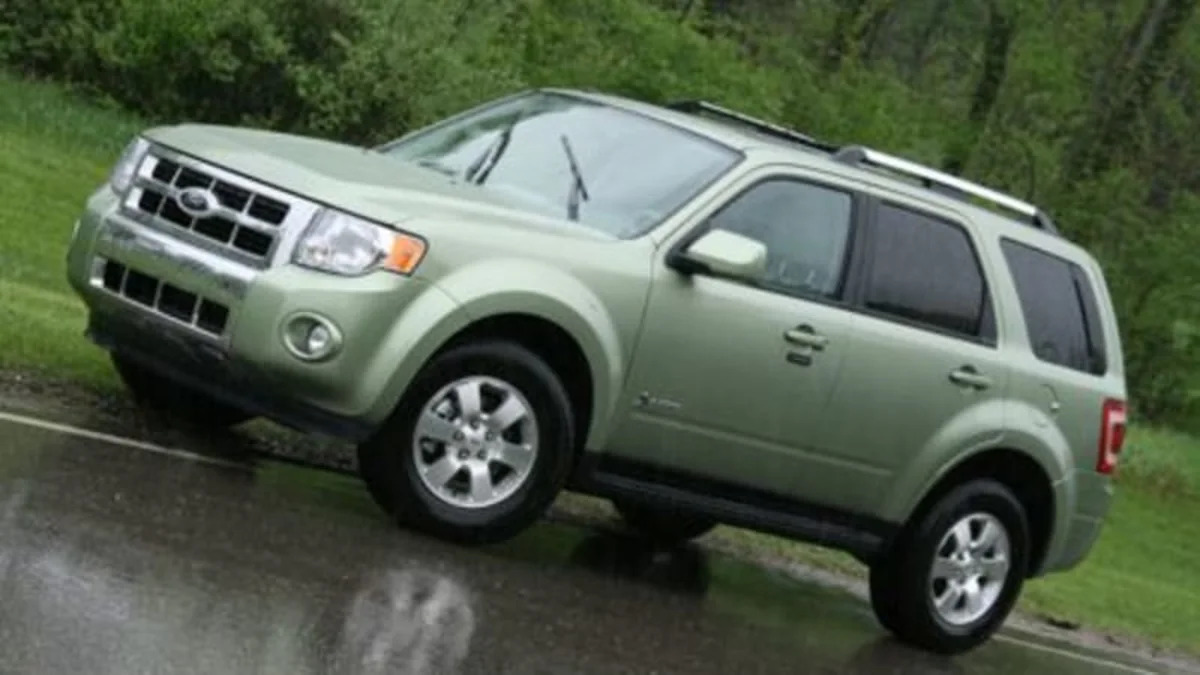Click the 2009 Escape Hybrid for a high res gallery
When we visited with the 2008 Ford Escape hybrid last year, it had just received a whole new look. It went from the softer, rounder appearance of the first-generation model that debuted in 2001 to a sharper-edged look more in keeping with its big brothers in the Ford Truck lineup. The 2008 changes were almost entirely visual with most of the major mechanical bits carried over from 2007. Nonetheless, the changes seem to resonate with consumers. Sales of the Escape were up almost ten percent in the first four months of 2008 compared to last year, even while the market as a whole was down.
For 2009, Ford has addressed the mechanical side of the Escape equation with new powertrains across the board along with a host of other upgrades. Both the four and six cylinder engines have been upgraded and the former four speed automatic transmission has been replaced with a brand new six speed that we told you about last week. The hybrid model has also been rewarded with a new brake system that provides better pedal feel and finally adds traction and stability control. We headed out to the wilds of Pinkney MI to sample the upgraded Escape and you can read about it after the jump.
Photos Copyright ©2008 Sam Abuelsamid / Weblogs, Inc.

While the 2009 Escape (and its Mercury Mariner twin) are mostly about under-the-skin changes, there are a couple of minor changes that you can see on the outside if you look really carefully. The most prominent is a new chin spoiler under the front bumper that now extends further down, has more curvature and reaches across the full width of the vehicle from wheel to wheel. According to Ford, at 70mph the aerodynamic drag reduction just from this deeper spoiler is responsible for 2/3mpg increase in fuel efficiency. Additionally, models that aren't equipped with faired-in running boards have small spats in front of the rear tires that help direct air-flow around the tires.
Under the hood, the previous 2.3L four cylinder has been replaced with a redesigned 2.5L unit that gets variable intake cam timing for both the conventional and hybrid variants. The extra displacement and cam adjustability provide a 18hp bump to 171hp for the standard variant. The 3.0L V6 gains 40hp for a total of 240hp. Both engines are paired up with the new 6F35 six-speed automatic and the full package of refinements combine for a 1.7sec cut in 0-60 times and a 1mpg improvement in both city and highway mileage.

The hybrid version also gets the new 2.5L, but it's paired up with largely carryover hybrid hardware. That doesn't mean things haven't changed. The Escape engineering team expended a significant effort on refining the control of the hybrid system. The electronic brake hardware is also brand new for 2009. Like other strong hybrid systems, the Escape uses the abs system to control the hydraulic pressure at the wheels for blending friction and regenerative braking. Until the 2009 models, the system used on the Escape never had the capability to do traction or stability control even though these functions have been standard on conventional Escapes for several years. That oversight has been corrected now and I was able to try out on a slippery dirt road on the rain soaked spring day that we drove the new models.
Besides the powertrains, the structure of the Escape has been beefed up through increased use of high-strength steels in the frame rails, A-pillars, and cross members. The improvements were immediately apparent when driving the '09 models back-to-back with some '08s that were on hand for comparison. Driving away the updated models felt quieter and more solid than the older units which almost sounded tinny by comparison. The difference in the level of refinement was actually rather startling. But that was just the beginning. We drove the Escapes over a 20-mile loop near Pinkney that included some around town driving, some more open rural roads, twists and turns and dirt roads.
The new Escape was very well behaved on everything but was particularly impressive in the curves where it handled far better than expected for such a vehicle. There-tuned suspension and tire package was very nicely damped, able to keep the body steady even over some very rough pavement. Roll control was much improved thanks to a first time anti-roll bar for the Escape.
In the non-hybrid four and six cylinder models, the new six speed was truly outstanding. Shifts were smooth and seamless from one gear to the next. When accelerating as if to pass, the shifts came quickly and without any jerking. The shorter steps between shifts also meant the drivetrain could be kept within a narrower rev band for quieter and more efficient operation.
In the hybrid the same improvements that were noticeable when I drove the prototype plug-in Escape in New York in March have been applied to the 2009 production models. The automatic starts and stops are now much smoother than before without the shudder that can be felt in many earlier hybrid models. Additionally, if the battery state of charge is sufficient the Escape can now go up to 40mph in EV mode compared to under 30mph previously. The new electronic stability control system is also a welcome addition to the Escape hybrid. On a wet dirt road it intervened fairly aggressively but for this type of vehicle that's probably a wise thing.
Overall the updates are a welcome improvement providing a much more refined feel to the new Escape, keeping it competitive with the competition from Asian and now European brands, like the new VW Tiguan.
Photos Copyright ©2008 Sam Abuelsamid / Weblogs, Inc.


Sign in to post
Please sign in to leave a comment.
Continue